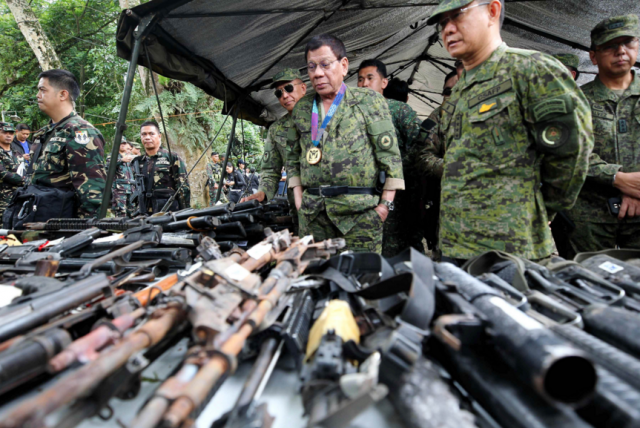
(UPDATED – 10:37 p.m.) MANILA, Philippines — While former Marine officer and Magdalo party-list Rep. Gary Alejano praised the government forces’ bravery in liberating Marawi City from the hands of Islamist extremists, the lawmaker also joined calls for the Duterte administration to pinpoint and comprehend the root causes of the problems in the South so it could have a more lasting solution to terrorism.
“Aside from the rehabilitation, I also reiterate my call for the government to identify and understand the root cause of the Marawi crisis. Terrorism is a global problem which needs our urgent attention,” Alejano said in a statement issued Tuesday, Oct. 17, a day after the military announced the death of ISIS-linked Maute Group and Abu Sayyaf leaders Omarkhayam Romato Maute and Isnilon Hapilon.
Academicians and experts on terrorism and the war in Mindanao have been calling on the Philippine government to take a deeper look at how to address the said problems beyond military means, pointing out that current counter-terrorist deterrence has only resulted in a vicious circle.
Leaders fall, leaders rise, groups mutate into sub-groups
In a media interview on Tuesday, Professor Julkipli Wadi, former dean of the University of the Philippines’ Institute of Islamic Studies, said the deaths of Maute and Hapilon were just a “setback” but the problem would continue because based on the history of the Abu Sayyaf Group, new leaders emerge following the death of their predecessors.
“(S)a kasaysayan ng Abu Sayyaf Group (ASG), tuwing may mamamatay, may uusbong at papalit…Obviously magkaka-setback, but hindi ibig sabihin na tapos na ang problema,” said Wadi in an interview with GMA News Online.
Wadi said it was also possible that like before, because their leader died, the group would simply “mutate” into sub-groups thereby making it harder for the government to determine where to focus its efforts or who to talk to because “there’s no central command.”
“From the pattern of experiences that the ASG has shown, every time there are leaders killed, after sometime, there will be another one that will take the cudgel and take the rein of the leadership. That’s the story of the Abu Sayyaf since the early ’90s onward,” Wadi said in a separate interview with CNN on Tuesday, mentioning the ASG leaders who rose and fell and replaced by new heads such as its founder, Abdurajak Janjalani, his brother, Khadaffy Janjalani, Aldam Tilao alias Abu Sabaya, Gumbahali Jumdail alias Dr. Abu, and Galib Andang alias Commander Robot.
“So it will just, I think, take few more time for them to probably form some kind of a consensus of who would they designate as a leader,” he added.
Marawi: New layer of conflict, new battleground
According to Wadi, “a new layer of conflict” had emerged from the nearly five-month battle in Marawi that was never seen before in the war in Mindanao, which used to only “rotate on Maguindanao, Sulu, and Basilan.”
“Now, with the Marawi war, a new battleground has actually been opened. There was no some kind of history into which Maranao radicals were able to last their resistance this far. There was in 1972, just a month after the declaration of martial law of President Marcos (that) Maranao radicals were able to rally around a hundred and also waged a kind of an initial rebellion but that only lasted for…two days then it was immediately quelled and that was not repeated,” he said.
“But this time, a five-month resistance is indeed truly new in the context of Maranao experience…and I think if there is a learning experience that the Maute and the Abu Sayyaf have now realized is that the war these past several months is a sense their training ground,” Wadi said.
‘Liberation of the mind is the most difficult’
What would be the next for Maranao radicals in Marawi following the death of their leaders?
Wadi said it could be possible that the relatives of those who were killed in the almost five-month battle “will in a sense take the vengeance or revenge.”
“(T)he fact that they had waged this difficult war, and now there are hundreds of relatives of…war victims, I’m afraid this can be potential recruits as what was shown in Sulu and Basilan,” he said.
“So this is what I’m saying, the most difficult liberation is the liberation of the mind from the bondage of radicalism that had sipped in in Marawi. So we are fighting here a war that is in my view…would probably stretch beyond the term of President Duterte.”
“We share the jubilation of the Armed Forces but we are equally concerned of the long-term effect and what’s up ahead for the future of Mindanao.” added Wadi.
Poverty, weak state, and extremism
Meanwhile, Corinne Graff, a senior policy scholar at the U.S. Institute of Peace, wrote that poverty in countries such as those being experienced in the Philippines, Mali, Yemen, and Pakistan “undermines government capacity and allows violent extremists to use ungoverned territories as staging grounds for international attacks.”
“Poor, weak states with inadequate border and territorial controls fit the bill. They serve as a sanctuary for violent extremist groups and their cells and hubs and lack legitimacy in the eyes of their citizens. Particularly susceptible are underserviced regions, such as the Federally Administrated Tribal Areas in Pakistan, the southern Philippines, northern Mali or parts of southern and northern Yemen,” said Graff, former deputy assistant administrator for Africa at the U.S. Agency for International Development where she oversaw Sudan and South Sudan programs and Africa Bureau efforts on countering violent extremism and security governance.
According to Graff, “poor countries that have the least capacity to prevent or respond to terrorist attacks can easily become locked in a doom spiral.”









